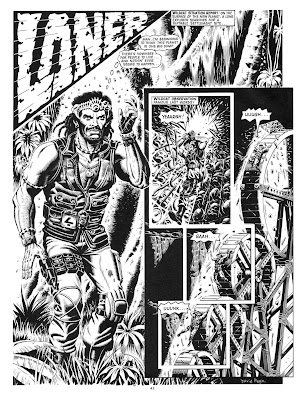'My Father, the Pornographer: A Memoir'
by Chris Offutt
Washington Square Press, April 2017
As a teenager and sci-fi reader during the 1970s, I was aware of Andrew J. Offutt (who often used the lower-case spellings of his first name and surname as a 'gimmick') as an author and editor of sci-fi and fantasy books.
He and his contemporary, Karl Edward Wagner, represented a younger generation of fantasy writers who were inheriting the legacy of people like Lin Carter and L. Sprague de Camp. In large part, this inheritance consisted of writing new content, for the paperback publishers of the 1970s and 1980s, for Robert E. Howard properties like Conan, Cormac Mac Art, and Bran Mak Morn.
I thought that Offutt was superior to Wagner as both an editor of fantasy anthologies, and as a novelist.
As the 70s gave way to the 80s, Offutt's profile gradually became less noticeable, maintained in large part by his contributions to the Robert Lynn Aspen shared-world series Thieves' World. By the end of the 80s, Offutt had pretty much disappeared from the sci-fi publishing landscape.
What I didn't know was that from 1982 to 1985 Offutt, under the pseudonym 'John Cleve', was the author / co-author of all 19 books in a softcore porn sci-fi series from Playboy Press called 'Spaceways'.
I also didn't know that during the 60s and 70s, Offutt had published around 130 sleaze paperbacks under the pseudonym 'John Cleve'. Additional titles were published using any one of another 17 pseudonyms.
When the sleaze paperback market evaporated in the mid-1980s, the indefatigable Offutt began his own line of mail-order chapbooks, 'Winter Books'. Up until 2011 he issued over 250 porn novels under the Winter Books imprint, using the pseudonym 'Turk Winter'.
Some of these Winter Books were written in conjunction with the famous fetish artist Ernest Stanzoni, Jr., better known as 'Eric Stanton'. While most Winter Books sold for $60 each, titles 'customized' for a client's particular sadomasochistic fantasies could sell for as much as $2600.
Indeed, as his son Chris Offutt makes clear in this memoir, Andrew Offutt was a pornographer who wrote science fiction and fantasy, rather than a science fiction writer who wrote pornography. The scope of his father's dedication to writing porn only became apparent to Chris Offut when, in 2013, the year his father died of cirrhosis, Chris inherited 1800 pounds of books, letters, manuscripts, comic books, and other media.
And, as is apparent from the earliest chapters of 'My Father', Andrew Offut was not a pleasant or likeable man. Andrew Offutt was an arrogant, self-centered martinet who considered his wife and children to be annoyances, a man who would erupt into anger over a perceived slight and bear a grudge for the rest of his life (the book describes how the UK writer Piers Anthony Jacob, aka 'Piers Anthony', mentored Offutt's first forays into sleaze paperbacks. But when Jacobs angered Offutt, one day the latter nailed one of Jacobs's books onto a log in the backyard of the Offutt family home in Haldeman, Kentucky).
left to right: Mary Jo McCabe Offutt, Andrew Offutt, unknown man and woman, 'Dead Dog' party, 1969 St. Louiscon. Jay Kay Klein archive, Calisphere
Rusty Hevelin, left, and Andrew J. Offutt, right, at Midwestcon 57, June 2006. MidAmerican Fan Photo Archive
'My Father, the Pornographer' is a very readable memoir, one that will appeal to any fan of sci-fi and fantasy fiction published during the 60s and 70s (Chris Offutt's account of attending science fiction conventions during that era are laugh-out-loud funny, but also creepy).
Baby Boomers will find the book an interesting account of growing up in that era; for example, when Chris Offutt writes about how his father took him to see Billy Jack in 1971, it's sure to evoke memories of a time and a place for any Boomer.
Chris Offutt posing with his father's media collection......and firearm. From The New York Times, February 15, 2015
My one complaint about 'My Father' is that it doesn't include any photographs. Including pictures of Offutt, his family, his Kentucky home and office, and period photographs of the town of Haldeman, would have helped flesh out the people and places mentioned in the memoir.
Summing up, whether you're an Andrew Offutt fan, a fan of 70s sci-fi, a fan of sleaze paperbacks, or simply someone who enjoys a well-written memoir, then 'My Father the Pornographer' is worth searching out.




































































